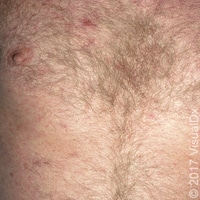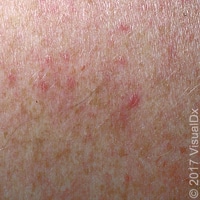Part 4 | Differential Diagnosis of an Unusual Rash
Self-paced online dermatology course
If you can accurately describe a rash and have taken a basic patient history, you are very close to a diagnosis. While the “common lists” can serve as a foundational dermatology curriculum for medical student education and help with common disease diagnosis, arriving at a diagnosis when a patient presents with an unusual rash and a complex medical history can be challenging.
Case Study
Consider a 28-year-old patient who has recently returned from work with the Peace Corps in Haiti and is presenting with widespread, blanching macules and a prominent fever.
If you are medical student or resident at an institution with access to VisualDx, click here to log in or use a 15-day free trial to build your differential diagnosis within the Fever and Rash module, now that you are an expert in the language of dermatology.


(See below for the findings entry search sequence for the example above.)
Search I: Differential diagnosis of blanching macules in a patient with fever (using VisualDx)
Search 2: Differential diagnosis where a widespread distribution of macules is considered (using VisualDx)
Search 3: Differential diagnosis of blanching macules, widespread distribution, and arthralgias (using VisualDx)
Search 4: Differential diagnosis of blanching macules, widespread distribution, arthralgias, and travel to Haiti (using VisualDx)
For Patients:
To understand the differential diagnostic process by using an age and body location diagnostic approach, try the Rash Skin Condition Finder.
Continue to Part 5: Common and Serious Dermatologic Conditions →
Published on 10/27/2016 | Last updated on 05/12/2017